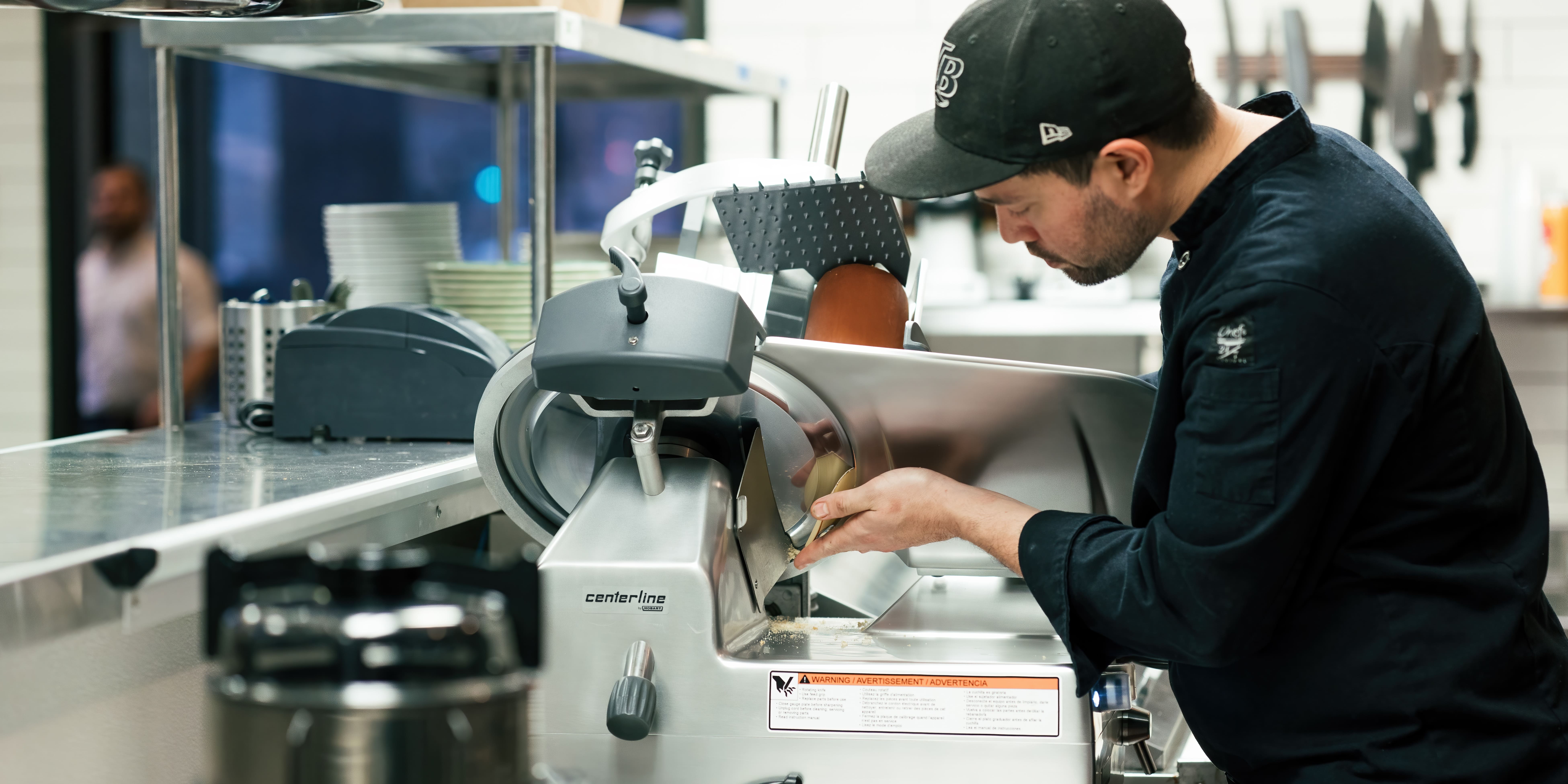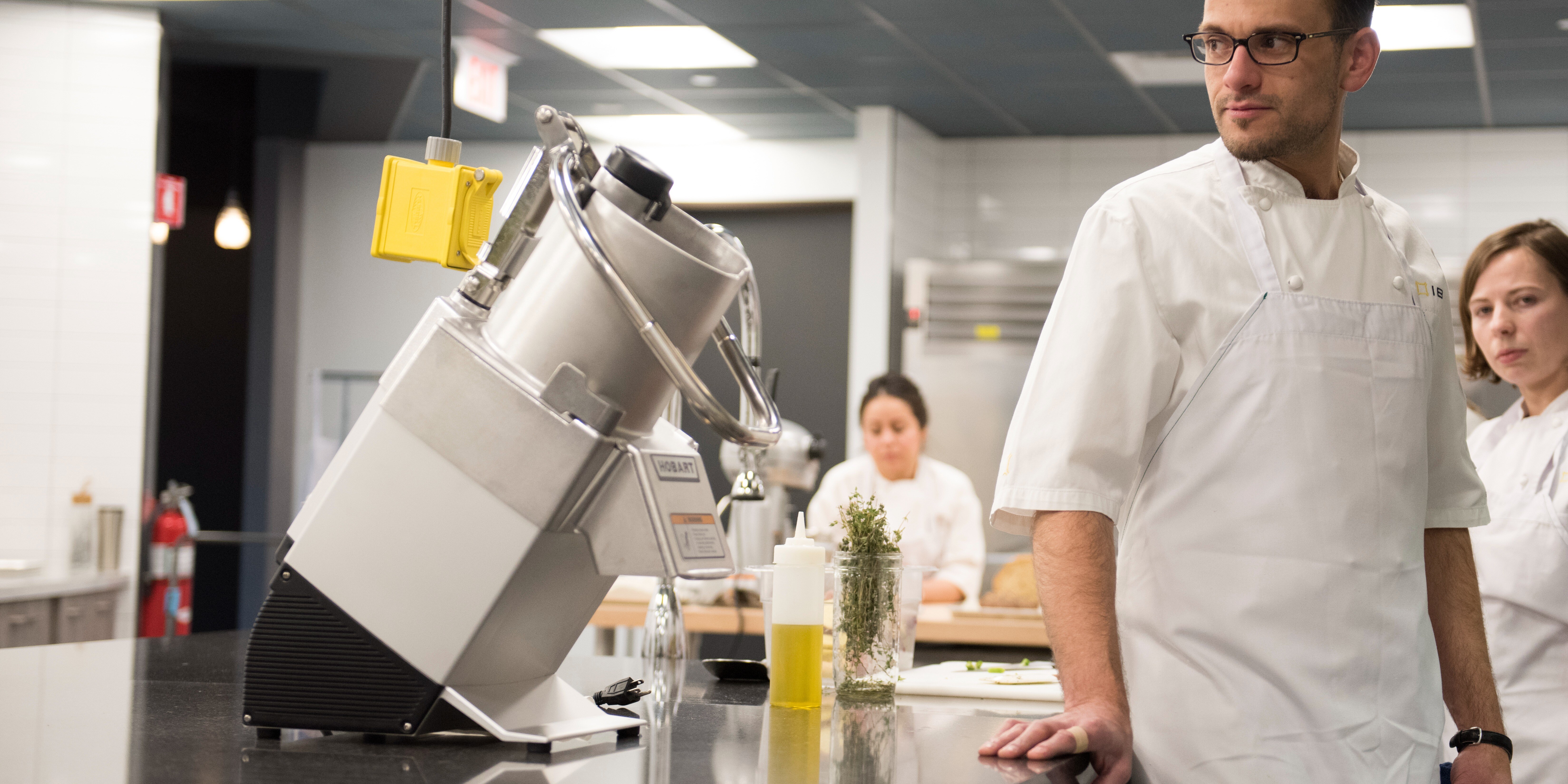At Evanston Township High School (ETHS), meals are a big production. That’s because the school has four student cafeterias that its central kitchen serves, along with a cafeteria for staff, 12 elementary schools in a separate district and four area daycares. Combined, these schools and daycares have over 5,000 attendees with around 40% participating in the lunch program throughout the school year. Add to that aftercare snacks and 1,000 students in summer programs and it’s clear the ETHS kitchen is making a lot of meals.
Even so, it’s not all about the volume of meals made every day, according to Kim Minestra, nutrition service program director at ETHS.
“The same work goes into feeding 20 people as 2,000,” she explained. “We have a focus on training staff and organizing them so they can be their most efficient. Thankfully, we don’t have the labor shortages that many other schools experience, so that’s an advantage.”
With ETHS becoming a recent recipient of The Hobart Equipment Grant through the School Nutrition Foundation, Minestra has two new pieces of equipment to train employees to use to streamline food preparation. The Hobart HCM61 bowl-style food processor and a HS9 heavy-duty automatic slicer are also helping the ETHS staff provide more semi-scratch menu options to students in the high school, in particular.
Student involvement in nutrition
Healthy eating is important to many students at ETHS and the school encourages them to make smart food choices. They also work to educate students about the benefits it has on their physical, mental and academic well-being.
“We have students in all these sports, so they need sustenance to perform,” said Minestra. “And on testing days, we provide a healthy breakfast and encourage them to eat prior. We’ll put tables out like in the hallway for them, so it's easy for them to grab and go.”
The school also encourages students to get involved with the ETHS gardens and greenhouse. The ETHS greenhouse has been part of the Nutrition Services program since 2014 and provides seedlings for the gardens. Edible Acre I is a 5,000 square foot space that yields between 2,200 and 3,000 pounds of produce during the April to November growing season. At Edible Acre II, students grow romaine to supply salads for lunches. There is also an Edible Orchard with pear and apple trees.
“Students can take an active role in learning about gardening and harvesting produce by enrolling in the Urban Agriculture course that takes place in the greenhouse,” explained Minestra. “We also have an employment program that hires students to work in the gardens during the summer. We serve whatever we can throughout the summer to those who are taking classes.”
Students can also get involved through after-school gardening sessions held each week or garden to fulfill volunteer hours.
Help from Hobart
Minestra and the ETHS staff are putting their commitment to fresh, quality food to work with their new Hobart equipment.
“We really try to do as much semi-scratch as possible,” said Minestra. “Our students are very accepting of that, and we take steps to make the meals especially appealing to them. We’ll plate up examples of what items are on the serving line for them. For example, how they can put together a burrito bowl with rice, meat and fresh salsa.”
Fresh salsa is one of the menu items introduced since using their new HCM61 bowl-style food processor. This machine has Hobart-exclusive COOLCUTTER™ design that use two stainless steel turning knives to force product into two stainless steel serrated cutting knives. The result is faster processing with minimal temperature increases.
Staff are also using the new food processor to make marinara and pesto, and to chop herbs. Hummus is another new menu item.
“The hummus has been a big hit. We do tons of that,” said Minestra. “We don’t just make it with garbanzo beans either. We make black bean and white bean hummus, too. We serve it in the high school and send it in bulk to the elementary school to serve with veggies or a chicken shawarma pita.”
In addition to the hummus being well received by students, it’s also less expensive to make compared to purchasing pre-made and it’s more sustainable. Minestra sources the beans with commodity dollars from USDA Foods without the extra packaging.
ETHS is also saving money by slicing meats and cheeses with their new HS9 automatic slicer and there is less waste due to the higher quality of the sandwiches and wraps they are making with these ingredients. Students tend to select these menu options more frequently now.
“Students have noticed a difference in quality,” Minestra said. “We like having the ability to slice different thicknesses and to provide fresh new options. And for the summer school program, we serve sandwiches, so we’ll be using the slicer for those.”
The HS9 automatic slicer features a double-action indexing cam that allows for adjustments for shaving, chipping and thin slicing, along with thick slicing. The gauge plate holds meats and cheeses in place for precision and consistent slicing. The slicer also features a 13-inch CleanCut™ knife with a cobalt alloy edge that stays sharp and lasts two to three times longer than carbon steel knives.
A feature on the HS9 slicer that Minestra appreciates is the lift assist, which raises the slicer so that it’s easy to clean underneath. It helps speed cleaning, so staff save time.
According to Minestra, the ETHS kitchen staff have been receptive to using the new Hobart bowl-food processor and the slicer. Training took place in small groups and was easy to conduct, given the features of the equipment.
“This equipment is the easiest to use of any equipment in the kitchen and the staff likes it,” she said. “They also take pride in creating something fresh for students, as it goes beyond the mindset of ‘heat and eat.’ And when they put all the work into preparing food and it doesn’t come back to the kitchen, that’s good.”
About the Author
 Grace Strotman is the marketing & K-12 segment specialist for Hobart – Food Preparation Products. She has been with Hobart since 2020 and is responsible for marketing communications for the full line of Hobart food preparation equipment, with an added focus on the K-12 segment. See all her blogs here.
Grace Strotman is the marketing & K-12 segment specialist for Hobart – Food Preparation Products. She has been with Hobart since 2020 and is responsible for marketing communications for the full line of Hobart food preparation equipment, with an added focus on the K-12 segment. See all her blogs here.


.jpg)


-min.jpg)





